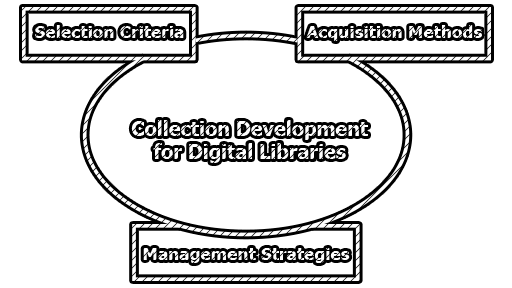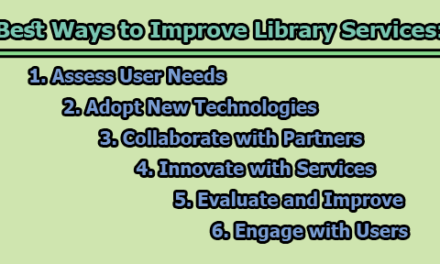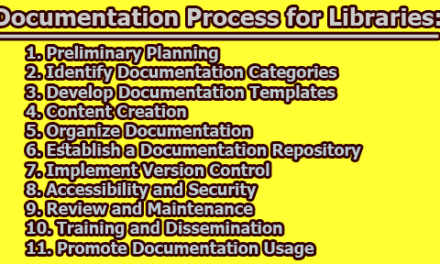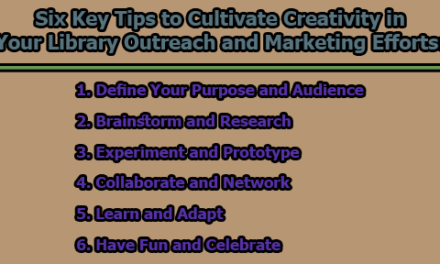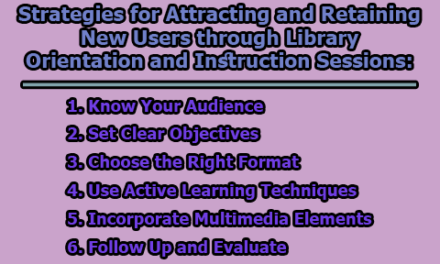Collection Development for Digital Libraries:
Collection development for digital libraries refers to the process of selecting, acquiring, and managing digital resources for a digital library. This process involves understanding the information needs of the library’s users, evaluating and selecting digital resources that meet those needs, acquiring the selected resources, and managing them effectively to ensure that they remain relevant and accessible to users over time. Collection development is a critical function of digital libraries, as the success of the library largely depends on the quality and relevance of its digital collections. This article will discuss the key aspects of collection development for digital libraries, including the selection criteria, acquisition methods, and management strategies.
- Selection Criteria: The selection criteria for digital resources differ from those for print resources. Digital resources may include e-books, e-journals, databases, audio and video files, images, and other multimedia content. The following are some of the selection criteria that digital libraries should consider when selecting digital resources:
-
- Relevance: Digital resources should be relevant to the information needs of the library’s users. The library should consider the subject areas, topics, and formats that are most in demand by its users.
- Authority: Digital resources should be created and/or maintained by reputable sources. The library should consider the credentials of the creators, publishers, and vendors of the resources.
- Currency: Digital resources should be current and up-to-date. The library should consider the frequency of updates and the timeliness of the content.
- Accessibility: Digital resources should be accessible to all users, including those with disabilities. The library should consider the accessibility features of the resources, such as screen reader compatibility and captioning for video files.
- User-Friendliness: Digital resources should be easy to use and navigate. The library should consider the user interface, search capabilities, and other features that affect the user experience.
- Cost: Digital resources should be cost-effective. The library should consider the cost of acquiring and maintaining the resources, as well as any subscription or licensing fees.
- Acquisition Methods: Digital libraries can acquire digital resources through a variety of methods, including purchasing, licensing, and partnering with other institutions. The following are some of the acquisition methods that digital libraries should consider:
-
- Purchasing: Digital libraries can purchase digital resources directly from vendors or publishers. This method allows the library to own the resources outright and provides greater control over the content.
- Licensing: Digital libraries can license digital resources from vendors or publishers. This method allows the library to access the content without owning it outright and may provide more flexibility in terms of cost and access.
- Consortia: Digital libraries can partner with other institutions to acquire digital resources as a group. This method allows the library to leverage the collective buying power of the group to negotiate better prices and access to resources.
- Open Access: Digital libraries can acquire digital resources that are freely available online through open-access repositories and websites. This method allows the library to provide access to high-quality content without incurring significant costs.
- Management Strategies: Once digital resources have been acquired, digital libraries must manage them effectively to ensure that they remain relevant and accessible to users over time. The following are some of the management strategies that digital libraries should consider:
-
- Metadata: Digital libraries should create and maintain metadata for each digital resource. Metadata provides descriptive information about the resource, such as its title, author, and subject matter, and enables users to discover and access the resource more easily.
- Preservation: Digital libraries should establish preservation strategies to ensure the long-term accessibility and usability of digital resources. Preservation strategies may include creating backup copies, migrating content to new formats, and monitoring the health and stability of the digital repository.
- Discovery: Digital libraries should make it easy for users to discover and access digital resources. This may include developing a user-friendly interface, providing robust search capabilities, and offering personalized recommendations based on user behavior.
- Usage Metrics: Digital libraries should track and analyze usage metrics to evaluate the impact and effectiveness of their digital collections. Usage metrics may include the number of downloads, the frequency of use, and the types of users who access the resources.
- Collection Development Policy: Digital libraries should establish a collection development policy that outlines the goals, objectives, and guidelines for selecting, acquiring, and managing digital resources. The policy should reflect the library’s mission and values, as well as the needs and preferences of its users.
Challenges and Opportunities:
Collection development for digital libraries presents several challenges and opportunities for librarians and information professionals. Some of the challenges include:
I. Selection: With the vast amount of digital resources available, selecting the most relevant and authoritative resources can be challenging.
II. Cost: Digital resources can be expensive, and licensing and subscription fees can be a significant financial burden for libraries.
III. Preservation: Ensuring the long-term preservation and accessibility of digital resources requires significant resources and expertise.
IV. Technological Obsolescence: Digital resources can become obsolete quickly, requiring libraries to migrate content to new formats and platforms.
However, collection development for digital libraries also presents several opportunities, including:
I. Access: Digital resources provide greater access to information and knowledge for users, particularly those who cannot physically access traditional library collections.
II. Collaboration: Digital libraries can collaborate with other institutions and organizations to acquire and share digital resources, thereby expanding their collections and enhancing their services.
III. Innovation: Digital libraries can leverage emerging technologies, such as artificial intelligence and machine learning, to improve the discovery and accessibility of digital resources.
It is apparent that collection development for digital libraries is a complex and multifaceted process that requires careful consideration of selection criteria, acquisition methods, and management strategies. Digital libraries must be proactive in addressing the challenges of selecting, acquiring, and managing digital resources, while also taking advantage of the opportunities that digital collections provide. By developing robust collection development policies and leveraging emerging technologies, digital libraries can enhance their services and provide greater access to information and knowledge for users.

Assistant Teacher at Zinzira Pir Mohammad Pilot School and College

